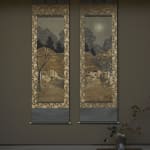Ushida Keison (1890–1976)
Yūgao from the Tale of Genji
Color on silk, pair of hanging scrolls
With a box signed by the artist
Seal: Keison (each)
127 x 41 cm each
221.5 x 56 cm each (overall)
Further images
The scene depicted is from “Yugao,” the fourth chapter of The Tale of Genji: en route to Lady Rokujo, Genji stops by Gojo to visit his ailing nurse. He attracts to an unknown white flower in bloom aside to a beautiful house with fences of plaited cypress. Being told that the flower has a feminine name yugao, or evening faces, Genji puts forward his servant to pick one for him. This conceited action seen in a young maid’s eyes is so undignified that she comes out and hands Genji a scented fan. Here a pair of scrolls illustrates the scene right after the first secret date of the seventeen-year-old Genji and the nineteen-year-old Yugao in someone’s lodge. With the luster of a full moon, the woods shrouded in the contrasting darkness create a lamentable atmosphere, as if it is an omen of Yugao’s miserable fate hereafter, evoking the viewers’ compassion.
Born in 1890, a Yokohama native, Ushida Keison studied at a commercial school in Eitai-bashi area in Tokyo at sixteen. After graduation, he worked at an oil trading company for merely two years. Aimed at becoming a nihonga painter, Keison attended Matsumoto Fuko’s private teaching atelier, the Angado-gajuku, with Imamura Shiko, Hayami Gyoshu, Omoda Seiju, and many others. It is extremely difficult to date this work owing to the fact that Keison’s paintings do not survive in numbers; yet, the atmosphere throughout this work indicates it was painted in the mid-Taisho period, the late 1910s, between his mid-twenties to thirties.
Ushida Keison (nihonga painter; 1890–1976)
Yokohama-born nihonga painter. His real name is Osamu. Studied at Matsumoto Fuko’s private school, Angado-gajuku. Exhibited at Songa-kai and Bunten. Later became a member of Nihon bijutsuin (Japan Art Institute). Co-founded Sekiyo-kai with Imamura Shiko, Hayami Gyoshu, Omoda Seiju, and others. His work features Yamato-e style colors and refined depictions. Received the Chogyu award at the fourth Inten. Besides painting, he was devoted to stage design for Kyomai under the name of Kasuga Ko in the postwar period.
Born in 1890, a Yokohama native, Ushida Keison studied at a commercial school in Eitai-bashi area in Tokyo at sixteen. After graduation, he worked at an oil trading company for merely two years. Aimed at becoming a nihonga painter, Keison attended Matsumoto Fuko’s private teaching atelier, the Angado-gajuku, with Imamura Shiko, Hayami Gyoshu, Omoda Seiju, and many others. It is extremely difficult to date this work owing to the fact that Keison’s paintings do not survive in numbers; yet, the atmosphere throughout this work indicates it was painted in the mid-Taisho period, the late 1910s, between his mid-twenties to thirties.
Ushida Keison (nihonga painter; 1890–1976)
Yokohama-born nihonga painter. His real name is Osamu. Studied at Matsumoto Fuko’s private school, Angado-gajuku. Exhibited at Songa-kai and Bunten. Later became a member of Nihon bijutsuin (Japan Art Institute). Co-founded Sekiyo-kai with Imamura Shiko, Hayami Gyoshu, Omoda Seiju, and others. His work features Yamato-e style colors and refined depictions. Received the Chogyu award at the fourth Inten. Besides painting, he was devoted to stage design for Kyomai under the name of Kasuga Ko in the postwar period.











